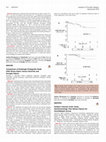Papers by Matthew Phaneuf

PubMed, Aug 1, 1994
The purpose of this investigation was to covalently bind recombinant hirudin (rHir) to albumin an... more The purpose of this investigation was to covalently bind recombinant hirudin (rHir) to albumin and compare alpha-thrombin inhibition by complexed rHir to rHir. rHir was radiolabelled with 125I and covalently bound to albumin using heterobifunctional cross-linking reagents. HPLC purification of the 125I-rHir-SMCC-albumin complex using gel filtration chromatography resulted in four elution peaks, with the main peak containing an average M(r) of 78 kDa. This peak fraction also contained 63% (+/- 1.4%) of the total protein and 49% (+/- 6.8%) of the 125I-rHir conjugated to albumin. Purification of unbound 125I-rHir from complex was confirmed by SDS gel electrophoresis and autoradiography. 125I-rHir inhibition of alpha-thrombin, measured by an assay utilizing the chromogenic tripeptide substrate H-D-Phe-Pip-Arg-pNA (S-2238), was observed to be non-competitive of linear mixed-type having a Ki of 1.61 pM and an alpha Ki of 1.09 pM. In contrast, complexed 125I-rHir was found to be a pure, non-competitive inhibitor having a Ki of 15.6 pM showing a ten-fold increase. These results demonstrate that covalently bound 125I-rHir still maintains potent alpha-thrombin affinity while losing minimal inhibitory capacity. Thus, successful modification of 125I-rHir serves as the foundation for future alternative applications for this potent inhibitor.
Woodhead Publishing Limited eBooks, Feb 24, 2012
The FASEB Journal, Apr 1, 2008

2014 40th Annual Northeast Bioengineering Conference (NEBEC), 2014
Intimal hyperplasia (IH) remains one of the primary causes of prosthetic vascular graft failure. ... more Intimal hyperplasia (IH) remains one of the primary causes of prosthetic vascular graft failure. The goal of this study is to engineer a vascular graft material that has the ability to knock down genes associated with IH by local delivery of a select siRNA moiety to cells surrounding the implant. Thrombospondin-2 (TSP-2), previously shown to have increased expression during graft implantation, is a logical candidate for knock down. TSP-2 siRNA, alone and when complexed with the transfection reagent polyethyleneimine (PEI), was incorporated into an electrospun poly(ethylene terephthalate) vascular graft material (ePET) via a simple dip-coating technique. TSP-2 siRNA complexed with PEI had the greatest attachment to the graft material. HAoECs showed attachment and continued proliferation. TSP-2 siRNA was internalized by human aortic endothelial cells (HAoECs) seeded on the dip-coated graft and displayed success in down-regulating TSP-2 gene expression as compared to controls after 3 days of culture. In vivo data verified transfection of a vessel wall when ePET graft was used as a surrounding sleeve. This proof of principal study demonstrates the potential of using an electrospun ePET graft to locally deliver siRNA in order to target genes associated with IH.

Medical and Healthcare Textiles, 2010
ABSTRACT Background Over 13 million medical devices are used annually in the United States, many ... more ABSTRACT Background Over 13 million medical devices are used annually in the United States, many of them based on fibrous materials, such as simple wound dressings, hernia repair mesh, catheter cuffs and to more prosthetic arterial grafts. All medical devices are prone to complications of infection, unregulated cellular growth, and undesirable blood clotting behavior. Currently available biomaterials do not emulate the dynamic biologic and reparative processes that occur in normal tissue to overcome these complications. Thus, a novel biomaterial for use in a wide range of medical devices to direct or enhance the normal healing processes of native tissue would improve patient morbidity and mortality Goal The goal of this study was to synthesize and characterize in vitro novel nanofibrous materials that contained biologically-active agents such as antimicrobial, antifungal and antiseptic agents. Our hypothesis was that the nanofibrous materials would serve as a “reservoir”, slowly releasing the active agents over an extended period of time. We employed electrospinning technology in order to synthesize the nanofibrous polyester materials. A major benefit of this process is that the polyester nanofibers are formed at low temperatures, unlike standard polyester fibers which are extruded as a melt at high temperatures. The low temperature permits the structure of the active compounds to remain intact, thus retaining their biological activity. Additionally, no exogenous binder agents or polymers are required to incorporate the respective agents. Variation of drug concentration into the bulk polymer solution prior to electrospinning was also examined. Results Evaluation of these drug-loaded polyester nanomaterials for drug release via UV/VIS spectrophotometry and subsequent biologic activity via specific biologic assay was performed for segments subjected to stringent washing conditions. These studies showed that active agent was released for an extended period of time (days to weeks) while maintaining activity upon release as compared to control nanofibrous polyester, which had no activity at any of the time periods examined. Activity of these surfaces was also controlled by the initial concentration loaded into the bulk polymer as indicated by our release and activity studies. Conclusions This study demonstrates that biologically-active agents can be individually incorporated into a nanofibrous polyester material. Additionally, these compounds are slowly released over an extended washing period. Lastly, these nanofibrous surfaces can maintain localized biological activity due to the drug elution from the nanofibrous material.
Journal of Surgical Research, 2013
Journal of Surgical Research, 2012

Purpose: The purpose of this study was to explore new strategies for enhancing specific cell type... more Purpose: The purpose of this study was to explore new strategies for enhancing specific cell type attachment to biomaterials using immobilized lectins for cell surface glycoconjugates. The lectin Ulex europaeus I (UEA I) has a high affinity for human vascular endothelial cell surface glycoconjugates. Methods: UEA I was covalently bound to polyethylene terephthalate (Dacron) with the cross-linking agent 1-ethyl-3-(dimethylaminopropyl)carbodiimide hydrochloride to achieve oligosaccharide-mediated endothelial cell attachment to this otherwise nonadherent surface. Results: Experiments with radiolabeled UEA I demonstrated covalent linkage of as much as 1.35 ~g/cm 2. The lectin binding site is available after the reaction, as demonstrated in experiments a neoglycoprotein. Adhesion studies reveal a 100-fold increase in endothelial cell attachment for the UEA I/polyethylene terephthalate surface (99.7 + 29.6 cells/high-power field) when compared with untreated (0.7 + 0.5), crosslinking agent (0.4 - 0.3), and denatured UEA I (1.2 + 1.1) control groups. Five vascular endothelial cell lines adhered to the UEA I/polyethylene terephthalate surface, whereas monocytes, smooth muscle cells, and fibroblasts did not. Conclusion: These results imply new strategies for endothelialization of prosthetic grafts and promotion of selective cell adherence to biomaterials, with emphasis on carbohydrate interactions. Moreover, this experimental system offers a model for exploring the biologic significance of the endothelial celI-UEA I ligand. (J VAse SURG 1993;18:48604.)

In a continuing effort to create an agent which has both thrombolytic and antithrombotic properti... more In a continuing effort to create an agent which has both thrombolytic and antithrombotic properties, streptokinase (SK) was covalently bound to the potent antithrombin agent recombinant hirudin (rHir). Linkage of SK to 125I-rHir was accomplished via heterobifunctional crosslinkers in an average molar ratio of 1:1. The 125I-rHir-SK complex was purified from starting components by anion exchange and gel filtration chromatography. The major band containing covalently bound 125I-rHir had a molecular weight of 53 kDa as determined by SDS-PAGE and autoradiography. Biologic activity of each component was then assayed utilizing the chromogenic substrate for each compound. Complex bound 125I-rHir exhibited a 1.2 fold decrease in thrombin inhibition when compared to concentrations of 125I-rHir greater than 3.13 nM. Complex bound 125I-SK, replacing the 125I label on rHir, displayed a 7.9-fold loss in plasminogen activation when compared to 125I-SK. These chromogenic assay results were not adversely altered in the presence of the converse compound's substrate. The 125I-SK-rHir complex (examined at various concentrations) also demonstrated a 0.17- to 17-fold greater affinity for thrombin immobilized onto Sepharose beads as compared to 125I-SK. These findings indicate the rHir-SK complex maintained both thrombolytic and antithrombin properties while also obtaining affinity for immobilized thrombin.

Journal of Vascular Surgery
Results: Rapamycin reduced AVF wall thickness at days 7 and 21 (P < .05; n ¼ 6) with no change in... more Results: Rapamycin reduced AVF wall thickness at days 7 and 21 (P < .05; n ¼ 6) with no change in AVF diameter (P ¼ .5). Rapamycin decreased the proliferation rate of smooth muscle cells (SMCs) and macrophages (P < .05), with reduced M1 (inducible nitric oxide synthase, tumor necrosis factor a) and M2 (interleukin 10, CD206) macrophages at days 3 and 7 (P < .05). Rapamycin treatment was associated with diminished phosphorylation of Akt1 and the mTORC1 pathway members mTOR (Ser2481), 4EBP1, and p70S6K (P < .05; n ¼6) but not of the mTORC2 pathway members mTOR (Ser2448) and serum and glucocorticoid-regulated kinase 1 (P > .4). With rapamycin treatment, there was decreased p-Akt1 and p-mTORC1 intensity in SMCs and macrophages at days 3, 7, and 21 (P < .05). There was also reduced p-endothelial nitric oxide synthase intensity in SMCs but not in endothelial cells. After depletion of macrophages with clodronate liposomes, there was reduced wall thickness (P < .01, day 21), SMC proliferation, and p-mTORC1 intensity in SMCs (P ¼ .001); however, AVF patency was reduced (P < .05). Rapamycin improved AVF patency by day 42 (P ¼ .04; n ¼ 14); these AVFs showed less thickening (P < .05) and had similar p-Akt1 and p-mTORC1 intensity in macrophages compared with control (P > .5). However, rapamycin treatment initiated after day 21 did not improve patency (P ¼ .62). Conclusions: Rapamycin improves AVF patency by reducing early inflammation and wall thickening while attenuating the Akt1-mTORC1 signaling pathway in SMCs and macrophages. Macrophages are associated with AVF wall thickening, and M2-type macrophages may play a mechanistic role in AVF maturation. Rapamycin is a potential translational strategy to improve AVF patency.

Asaio Journal, 2001
Infection is a major complication when using biomaterials such as polyurethane in the clinical se... more Infection is a major complication when using biomaterials such as polyurethane in the clinical setting. The purpose of this study was to develop a novel infection resistant polyurethane biomaterial using textile dyeing technology. This procedure results in incorporation of the antibiotic into the polymer, resulting in a slow, sustained release of antibiotic from the material over time, without the use of exogenous binder agents. Polycarbonate based urethanes were synthesized that contained either a non-ionic (bdPU) or anionic (cPU) chain extender within the polymer backbone and cast into films. The fluoroquinolone antibiotic ciprofloxacin (Cipro) was applied to bdPU and cPU using textile dyeing technology, with Cipro uptake determined by absorbance reduction of the &amp;amp;quot;dyebath.&amp;amp;quot; These dyed bdPU/cPU samples were then evaluated for prolonged Cipro release and antimicrobial activity by means of spectrophotometric and zone of inhibition assays, respectively. Cipro release and antimicrobial activity by dyed cPU segments that were aggressively washed persisted over 9 days, compared with dyed bdPU and dipped cPU control segments that lasted &amp;amp;lt; 24 hours. Dyed cPU segments, which remained in a static wash solution, maintained antimicrobial activity for 11 days (length of study), whereas controls again lost antimicrobial activity within 24 hours. Thus, application of Cipro to the cPU polymer by means of dyeing technology results in a slow sustained release of antibiotic with persistent bacteriocidal properties over extended periods of time.







Uploads
Papers by Matthew Phaneuf